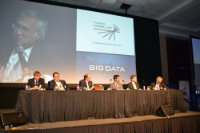Researchers and scientists at the Center for Mathematical Modeling at the Universidad de Chile (CMM) had an outstanding participation in the seminar Big Data: el valor de la información.
Among the five main speakers at the meeting was the director of the National Laboratory for High Performance Computing (NLHPC) Eduardo Vera. In parallel, researcher Felipe Tobar displayed a poster on the presentation of papers Astroinformatics Lab’s research was one of five works selected for a talk in the main hall.
The event, organized by the Copec-UC Foundation, is one of the most influential forums on innovation with representatives of industry and science in Chile.
The value of supercomputing
Vera shared stage with vice president of Product Development, Big Data and Data Analysis of IBM Rob Thomas, Google and HP consultant Bryan Eisenberg, IBM researcher Peter Hofstee, and Inria Chile executive director Claude Puech.
The CMM member spoke about the NLHPC experience. He talked on supercomputing capacity that Leftraru, Chile’s most powerful computer, and some researches developed both in science and in industrial applications. An important example was the case of Mining.
He also elaborated on challenges that combination of Big Data, high-performance computing to process data and information networks at high speed bring.
“Data scientists need not necessarily know about computers, but they should can work the data,” said Vera, who claimed 140 thousand of these experts are needed just in the US.“Another challenge is education, the penetration of these tools not only in research but also in society.” NLHPC director also emphasized the need for a national photonics network.
Posters and other talks
In parallel, there was a presentation of 20 posters with scientific innovations. Of these, two were from CMM members.
Felipe Tobar presented a mathematical model for processes that vary over time. This model uses machine learning concepts to self-adjust based on observed data and has lower computational costs than traditional approaches. The proposed method allows to estimate, predict and efficiently compress data from financial applications, weather, biomedical and audio; this methodology opens new possibilities for processing large volumes of data in different areas.
The results presented have been obtained under the “Machine Learning meets Signal Processing” Conicyt project, where Tobar is principal investigator. Theoretical extensions and new practical results, in collaboration with the group of machine learning University of Cambridge, will be presented on December 8th at the Neural Information Processing Systems conference in Montreal.
The Astroinformatics Lab also prepared a poster on the research that discovered 61 supernovae in real-time during six nights in February. They showed the process from design of the software to analyze the images where these stars were detected, photoshooting in the Tololo Observatory Hill, data transmission through the photonic network and the process of this information on the supercomputer. Today, they have discovered 135 supernovae in new revisions of the photos and improved the software. Their research was among five selected by the Copec UC Foundation from a total of 20 to be exhibited at the end of the seminar. The talk was given by CMM scientist Juan Carlos Maureira.
Source: CMM U.Chile

